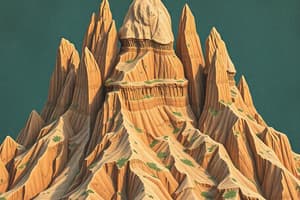Podcast
Questions and Answers
Which landform is primarily formed by tectonic forces such as folding and faulting?
Which landform is primarily formed by tectonic forces such as folding and faulting?
- Plateaus
- Plains
- Hills
- Mountains (correct)
What process primarily contributes to the formation of U-shaped valleys and fjords?
What process primarily contributes to the formation of U-shaped valleys and fjords?
- Sedimentation
- Glaciation (correct)
- Erosion
- Weathering
Which of the following best describes the process of sedimentation?
Which of the following best describes the process of sedimentation?
- Deposition of material transported by wind, water, or ice (correct)
- Wear away of rocks by wind and water
- Breakdown of rocks into smaller particles
- Movement of Earth's plates
What type of landform is characterized as an elevated flat area formed by volcanic activity?
What type of landform is characterized as an elevated flat area formed by volcanic activity?
Which landform results primarily from climatic conditions, erosion, and sediment deposition?
Which landform results primarily from climatic conditions, erosion, and sediment deposition?
Which process is involved in the breakdown of rocks into soil through physical, chemical, and biological means?
Which process is involved in the breakdown of rocks into soil through physical, chemical, and biological means?
What is the primary influence of the hydrological cycle on landforms?
What is the primary influence of the hydrological cycle on landforms?
Coastal landforms are primarily shaped by which two processes?
Coastal landforms are primarily shaped by which two processes?
What type of mountains are formed mainly by volcanic activity?
What type of mountains are formed mainly by volcanic activity?
Which of the following describes low areas between hills or mountains formed by erosion?
Which of the following describes low areas between hills or mountains formed by erosion?
Flashcards are hidden until you start studying
Study Notes
Different Landforms and Processes of Formation
1. Types of Landforms
- Mountains
- Formed by tectonic forces (folding, faulting).
- Types: Fold mountains, fault-block mountains, volcanic mountains.
- Hills
- Smaller than mountains; formed through erosion and sediment deposition.
- Plateaus
- Elevated flat areas; formed by volcanic activity or uplift.
- Plains
- Flat, low-lying areas; formed by sediment deposition from rivers or ocean floors.
- Valleys
- Low areas between hills or mountains; formed by erosion from rivers or glaciers.
- Deserts
- Arid regions with sparse vegetation; formed by climatic conditions, erosion, and sediment deposition.
- Glaciers
- Large ice masses that shape land through erosion; form U-shaped valleys and fjords.
- Coastal Landforms
- Formed by erosion and deposition from ocean waves; includes cliffs, beaches, and dunes.
2. Processes Involved in Landform Formation
- Tectonic Activity
- Movement of Earth's plates leading to the formation of mountains and rift valleys.
- Erosion
- Wear away of rocks and soil by wind, water, ice; shapes valleys, cliffs, and canyons.
- Weathering
- Breakdown of rocks through physical, chemical, and biological processes; contributes to soil formation.
- Sedimentation
- Deposition of material transported by wind, water, or ice; builds plains, deltas, and riverbanks.
- Volcanism
- Eruption of magma leading to the formation of volcanic landforms such as islands and mountains.
- Glaciation
- Movement of glaciers that carve out landscapes, leaving features like moraines and drumlins.
- Coastal Processes
- Actions of waves and tides shaping coastal landforms through erosion and deposition.
3. Key Concepts
- Plate Tectonics: Explains the movement of Earth's lithosphere and the creation of various landforms.
- Hydrological Cycle: Influences erosion and sedimentation processes.
- Climate: Affects weathering rates and types of landforms present.
Understanding these landforms and their formation processes is crucial in geology, geography, and environmental science.
Types of Landforms
- Mountains: Created by tectonic forces like folding and faulting, categorized into:
- Fold mountains: formed from plate collisions.
- Fault-block mountains: created by faulting, leading to uplift of blocks.
- Volcanic mountains: formed by volcanic activity through eruptions.
- Hills: Smaller than mountains, typically shaped by erosion and the deposition of sediment.
- Plateaus: Elevated flat regions formed by volcanic activity or the uplift of land due to tectonic actions.
- Plains: Low-lying flat areas resulting from sediment deposition by rivers or oceans, known for fertile soil.
- Valleys: Depressions between hills or mountains shaped primarily by erosion from rivers or glaciers.
- Deserts: Dry regions characterized by minimal vegetation, formed due to climatic conditions and erosion.
- Glaciers: Massive ice formations that sculpt landscapes through erosion, creating features like U-shaped valleys and fjords.
- Coastal Landforms: Formed by ocean wave action and sediment processes, including cliffs, beaches, and sand dunes.
Processes Involved in Landform Formation
- Tectonic Activity: Movement of Earth’s tectonic plates responsible for creating mountains and rift valleys.
- Erosion: Process of wearing away rocks and soil by wind, water, and ice, leading to the formation of valleys, cliffs, and canyons.
- Weathering: Breakdown of rocks into smaller particles through physical, chemical, and biological mechanisms contributing to soil development.
- Sedimentation: Accumulation of materials transported by natural forces (wind, water, ice), which leads to the formation of plains, deltas, and riverbanks.
- Volcanism: Involves the eruption of magma, resulting in various landforms such as islands and volcanic mountains.
- Glaciation: Ice movement from glaciers reshapes the landscape, forming features like moraines and drumlins.
- Coastal Processes: Erosion and deposition driven by the actions of waves and tides, creating distinctive coastal landforms.
Key Concepts
- Plate Tectonics: A fundamental theory explaining the movement of Earth’s lithosphere, instrumental in forming diverse landforms.
- Hydrological Cycle: Affects the rates of erosion and sedimentation, influencing landscape dynamics.
- Climate: Influences weathering processes, contributing to the diversity of landforms based on regional conditions.
Studying That Suits You
Use AI to generate personalized quizzes and flashcards to suit your learning preferences.




